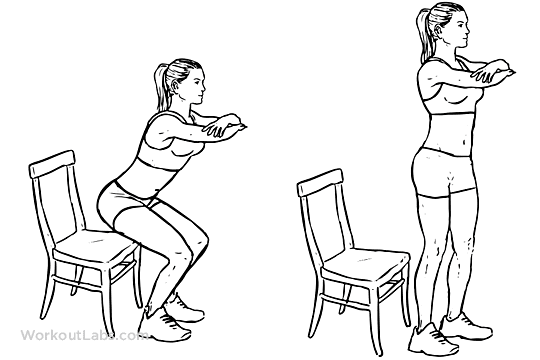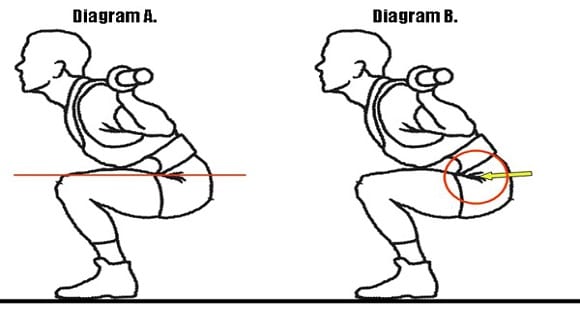By healthiergang writer , former competitive athlete and currently Bodybuilding athlete (Bikini category).
Box Squat
The Box Squat is one of the variants of the "king" of exercises in the gym. Variant that, not only can be used in a preparatory way for neophytes but also to improve some subtleties of the motor scheme or as a functional exercise, within a long-term planning, to improve the performance of the Powerlifting athlete in the lift.
We will go, in this article, to analyze all three of these possible functions not without first having explained how to perform the variant.
How is it done?
The Box Squat is a Squat which is however limited to first part of the ROM, until just below the parallel, going to use, precisely, a box, that is a "box". There are special tools but one can also be used stool or a slightly declined bench (or particularly low).

You will therefore go to detach the barbell, look straight, you will take a step back, compact torso, take air and descend, taking care of the technique as much as possible (lumbar curve, knees, legs). It will go down until it touches the box, from here there are two variants, as we will see.
In a first variant the box must be touched so as to become a reference point to then move on to the ascent out of the hole.
A second variant involves unloading the weight (part of it) on the box and then restarting. The variants certainly have different functions but they are both valid, the important thing is to always contextualize them!
Beginners
A first use for the Box Squat is, as we have seen, for beginners. We are talking about people who have not yet learned it motor scheme of the squat and, above all, they cannot count on a great strength of the legs and the posterior kinetic chain.
One of the initial problems is also having to become familiar with projecting the weight backwards, thus having a more rear-placed center of gravity than usual. The box solves most of these problems by giving a point of support that makes the subject confident in trying the gesture as well as giving a valid point of reference for the depth of the squat.
The point around the parallel is also the most difficult point of the ascent. The box allows you to release tension and fatigue so you can work safely on the motor pattern without giving in and / or risking injuries. This is even more true when starting to work with an unloaded or loaded barbell.
? Example program
Let's see a program that can be used in this case to learn the motor pattern and gesture.
Preparatory Box Squat
As mentioned, the box squat can also be used in a preparatory way for more or less advanced subjects who are already familiar with the motor pattern.
This can be done to improve some subtleties that can get lost "along the way", especially if our focus becomes performance (so lift as much weight as possible and yes, I mean you girls too!).
So let's see what are the cases in which exercise can be useful.
? Improvement of the descent
A first case may be to improve the descent. In particular in finding the feeling with the contraction that tends to be lost in approaching the parallel. With the box the athlete has the opportunity to approach more slowly relying on support in case of failure.
This expedient is quite useful as a more controlled descent allows not only to avoid excessive rebounds and joint stress but also to be able to count on a more precise adjustment and therefore on a firmer and safer (as well as efficient!) Ascent.

? Proprioception of the point of arrival
Another case may be that of improve the point of arrival (hence the depth) of the squat. Very often the athlete loses the proprioception of the gesture, believing he is going down more than he actually does. The box can therefore be set precisely in order to be a guide and reference point. In a few weeks the lost confidence will be found again.
In both cases what I would recommend is to start training (eventually warm up) with the Box Squat and then, in any case, always switch to the simple squat in order to transfer the gains to the first one on the final motor scheme.
Box Squat for Advanced
In the case of advanced subjects instead the Box Squat is an excellent variant to vary the work on the basic gesture. Thus, for example, one could insert within the wavy periodization, a first session of heavy and well-set Squat and a second session of Box Squat with different TUTs, isoholds, specific works and possibly assistance from bands or chains. Example:
? Day 1
Squat 5×5
Stance Narrow 4 × 10 press
Leg Extension 4×10
? Day 2
Leg Curl 4×15
Box Squat 5 × 5 with 5 '' of isohold at the point of maximum descent
Stance Largo 4 × 10-8-6-6 press
Glute Machine 4×8-6-4-10
In the first day we will therefore have a focus on the quadriceps after having done a Squat work (5 × 5, probably within a long-term programming) while on the second day we will go to work with a focus on hamstrings and buttocks, with an initial pre-fatigue on the Leg Curl and a final exercise on the Glute Machine.
Conclusions
The Box Squat is therefore a really interesting variant that can be inserted at any time (we could say “at any age”). The take-home message of this article, however, wants to be another. Each exercise has different logics and different possibilities of use, there are and should not be standardizations in terms of their use. The exercises must be contextualized and inserted according to:
? The transfer to a basic skill or motor pattern.
? The final goal you want to achieve.
Given these logics as the basis for choosing the different parameters of the board, it will only be a question of going to the room and squeezing yourself beyond belief trying to stay focused as much as possible!


























